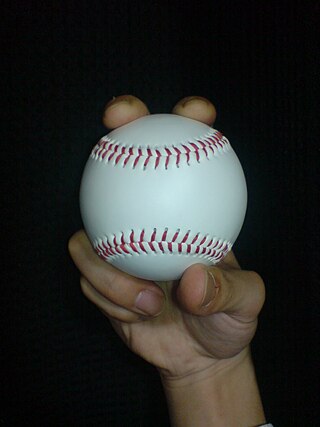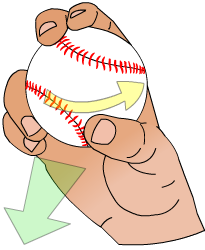
A knuckleball or knuckler is a baseball pitch thrown to minimize the spin of the ball in flight, causing an erratic, unpredictable motion. The air flow over a seam of the ball causes the ball to change from laminar to turbulent flow. This change adds a deflecting force to the baseball, making it difficult for batters to hit but also difficult for pitchers to control and catchers to catch; umpires are challenged as well, as the ball's irregular motion through the air makes it harder to call balls and strikes. A pitcher who throws knuckleballs is known as a knuckleballer.

In baseball, the pitcher is the player who throws ("pitches") the baseball from the pitcher's mound toward the catcher to begin each play, with the goal of retiring a batter, who attempts to either make contact with the pitched ball or draw a walk. In the numbering system used to record defensive plays, the pitcher is assigned the number 1. The pitcher is often considered the most important player on the defensive side of the game, and as such is situated at the right end of the defensive spectrum. There are many different types of pitchers, such as the starting pitcher, relief pitcher, middle reliever, lefty specialist, setup man, and the closer.

The fastball is the most common type of pitch thrown by pitchers in baseball and softball. Its distinctive feature is its high speed. "Power pitchers," such as former American major leaguers Nolan Ryan and Roger Clemens, rely the speed of the fastball to prevent the ball from being hit and throw fastballs at speeds of 95–105 miles per hour (153–169 km/h) (officially) and up to 108.1 miles per hour (174.0 km/h) (unofficially). As an alternative to the fastball, pitchers can put movement on slower thrown balls, or throw them towards the inside or outside of home plate where batters cannot easily reach it.

In baseball and softball, the curveball is a type of pitch thrown with a characteristic grip and hand movement that imparts forward spin to the ball, causing it to dive as it approaches the plate. Varieties of curveball include the 12–6 curveball, power curveball, and the knuckle curve. Its close relatives are the slider and the slurve. The "curve" of the ball varies from pitcher to pitcher.

A changeup is a type of pitch in baseball and fastpitch softball.

In baseball, a starting pitcher or starter is the first pitcher in the game for each team. A pitcher is credited with a game started if they throw the first pitch to the opponent's first batter of a game. Starting pitchers are expected to pitch for a significant portion of the game, although their ability to do this depends on many factors, including effectiveness, stamina, health, and strategy.
A screwball is a baseball and fastpitch softball pitch that is thrown so as to break in the opposite direction of a slider or curveball. Depending on the pitcher's arm angle, the ball may also have a sinking action. The pitch is sometimes known as the scroogie or airbender.

In baseball, the pitch is the act of throwing the baseball toward home plate to start a play. The term comes from the Knickerbocker Rules. Originally, the ball had to be thrown underhand, much like "pitching in horseshoes". Overhand pitching was not allowed in baseball until 1884.

A two-seam fastball is a pitch in baseball and softball. It is a variant of the straight fastball. The pitch has the speed of a fastball and can also include late-breaking action caused by varying the pressure of the index and middle fingers on the ball.

In baseball, a breaking ball is a pitch that does not travel straight as it approaches the batter; it will have sideways or downward motion on it, sometimes both. A breaking ball is not a specific pitch by that name, but is any pitch that "breaks", such as a curveball, slider, or screwball. A pitcher who primarily uses breaking ball pitches is often referred to as a junkballer.

In baseball, a circle changeup or circle change is a pitch thrown with a grip that includes a circle formation, hence the name circle changeup. The circle is formed by making a circle with the index finger, holding the thumb at the bottom of the ball parallel to the middle finger and holding the ball far out in the hand. The ball is thrown turning the palm out.

In baseball, a cut fastball or cutter is a type of fastball that breaks toward the pitcher's glove-hand side, as it reaches home plate. This pitch is somewhere between a slider and a four-seam fastball, as it is usually thrown faster than a slider but with more movement than a typical fastball. Some pitchers use a cutter to prevent hitters from expecting their regular fastballs. A common technique for throwing a cutter is to use a four-seam fastball grip with the baseball set slightly off center in the hand. A batter hitting a cutter pitch often achieves only soft contact and an easy out due to the pitch's movement keeping the ball away from the bat's sweet spot. The cutter is typically 2–5 mph slower than a pitcher's four-seam fastball. In 2010, the average pitch classified as a cutter by PITCHf/x thrown by a right-handed pitcher was 88.6 mph; the average two-seamer was 90.97 mph.
The slurve is a baseball pitch in which the pitcher throws a curve ball as if it were a slider. The pitch is gripped like a curve ball, but thrown with a slider velocity. The term is a portmanteau of slider and curve.
In baseball, an off-speed pitch is a pitch thrown at a slower speed than a fastball. Breaking balls and changeups are the two most common types of off-speed pitches. Very slow pitches which require the batter to provide most of the power on contact through bat speed are known as "junk" and include the knuckleball and the Eephus pitch, a sort of extreme changeup. The specific goals of off-speed pitches may vary, but in general they are used to disrupt the batter's timing, thereby lessening his chances of hitting the ball solidly or at all. Virtually all professional pitchers have at least one off-speed pitch in their repertoire. Despite the fact that most of these pitches break in some way, batters are sometimes able to anticipate them due to hints that the pitcher gives, such as changes in arm angle, arm speed, or placement of fingers.

A gyroball is a type of baseball pitch used primarily by players in Japan. It is thrown with a spiral-like spin, so that there is no Magnus force on the ball as it arrives at home plate. The gyroball is sometimes confused with the shuuto, another pitch used in Japan.
In baseball, a sinker or sinking fastball is a type of fastball which has significant downward and horizontal movement and is known for inducing ground balls. Pitchers capable of utilizing the sinker are able to throw the pitch almost exclusively, as it forces weak contact and ground balls, allowing them to rely less on secondary pitches in order to change speeds. While coaches agree that this pitch is very similar to the two-seam fastball, a two-seamer tends to have more lateral movement than a sinker. In either case, the pitch is thrown in a two-seam orientation and has a gyro angle far from 0 degrees, leading to seam-shifted wake effects that cause downward and lateral movement compared to a four-seam fastball.
The shuuto (シュート) or shootball is a baseball pitch. It is commonly thrown by right-handed Japanese pitchers such as Hiroki Kuroda, Noboru Akiyama, Kenjiro Kawasaki, Daisuke Matsuzaka, Yu Darvish and Masumi Kuwata. The most renowned shuuto pitcher in history was Masaji Hiramatsu, whose famous pitch was dubbed the razorshuuto because it seemed to "cut the air" when thrown.

The 12–6 curveball is one of the types of pitches thrown in baseball. It is categorized as a breaking ball because of its downward break. The 12–6 curveball, unlike the normal curveball, breaks in a downward motion in a straight line. This explains the name "12–6", because the break of the pitch refers to the ball breaking from the number 12 to the number 6 on a clock. While the 11–5 and 2–8 variations are very effective pitches, they are less effective than a true 12–6, because the ball will break into the heart of the bat more readily.

Taylor Heath Jungmann is an American former professional baseball pitcher. He played in Major League Baseball (MLB) for the Milwaukee Brewers and for the Yomiuri Giants of Nippon Professional Baseball (NPB). Prior to playing professionally, Jungmann played college baseball for the Texas Longhorns, where he was a consensus All-American and won the Dick Howser Trophy.

Max Dorian Fried is an American professional baseball pitcher for the Atlanta Braves of Major League Baseball (MLB). Drafted in 2012 by the San Diego Padres in the first round, seventh overall, Fried made his major league debut in 2017. His 17 wins in 2019 were 2nd-most in the National League, and his seven wins in 2020 were again 2nd-most in the NL. Fried pitched 6 shut-out innings in the final game of the 2021 World Series against the Houston Astros, helping lead the Braves to their first World Series title in 26 years. Through 2023, Fried had the best career win–loss percentage of all Braves pitchers, at .705.














